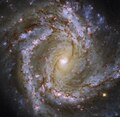Messier 61
| Galaxie Messier 61 | |
|---|---|
 | |
| Die Galaxie Messier 61, aufgenommen durch das Very Large Telescope | |
| AladinLite | |
| Sternbild | Jungfrau |
| Position Äquinoktium: J2000.0, Epoche: J2000.0 | |
| Rektaszension | 12h 21m 54,9s [1] |
| Deklination | +04° 28′ 25″ [1] |
| Erscheinungsbild | |
| Morphologischer Typ | SABbc / Sy2[1] |
| Helligkeit (visuell) | 9,3 mag[2] |
| Helligkeit (B-Band) | 10,1 mag[2] |
| Winkelausdehnung | 6,5′ × 5,9′[2] |
| Positionswinkel | 162°[2] |
| Inklination | 25° |
| Flächenhelligkeit | 13,1 mag/arcmin²[2] |
| Physikalische Daten | |
| Zugehörigkeit | Virgo-Galaxienhaufen, LGG 287[1][3] |
| Rotverschiebung | 0.005224 ± 0.000007[1] |
| Radialgeschwindigkeit | (1566 ± 2) km/s[1] |
| Hubbledistanz H0 = 73 km/(s • Mpc) | (66 ± 5) · 106 Lj (20,3 ± 1,4) Mpc [1] |
| Durchmesser | 100.000 Lj |
| Geschichte | |
| Entdeckung | Barnaba Oriani |
| Entdeckungsdatum | 5. Mai 1779 |
| Katalogbezeichnungen | |
| M 61 • NGC 4303 • UGC 7420 • PGC 40001 • CGCG 042-045 • MCG +01-32-022 • IRAS 12194+0444 • 2MASX J12215494+0428249 • VCC 508 • GC 2878 • H I 139 • h 1202 • | |
Messier 61 = NGC 4303 ist eine Spiralgalaxie vom Hubble-Typ SABbc im Sternbild Jungfrau auf der Ekliptik. Sie ist schätzungsweise 66 Millionen Lichtjahre von der Milchstraße entfernt und hat einen Durchmesser von etwa 100.000 Lj. Die Entfernungsmessungen basierend auf den Radialgeschwindigkeiten stimmen nicht mit den rotverschiebungsunabhängigen Entfernungsschätzungen von 48 ± 24 Millionen Lichtjahren überein.
M61 gehört zu den größeren Spiralgalaxien des Virgo-Galaxienhaufens, einer Ansammlung von Galaxien, die alle durch ihre gegenseitige Anziehungskraft zusammengehalten werden.
Das Objekt wurde am 5. Mai 1779 von Barnaba Oriani entdeckt.[4]
- UV-Aufnahme mit GALEX
- Infrarotaufnahme des Zentrums mit dem Spitzer-Weltraumteleskop
- (c) NASA, ESA, CSA, STScI, J. Lee (STScI), T. Williams (Oxford), PHANGS Team, CC BY 4.0Infrarotaufnahmen mithilfe des James-Webb-Weltraumteleskops
- Detaillierte Aufnahme mit der WFC3 des Hubble-Weltraumteleskops kombiniert mit der mit dem Instrument FORS des Very Large Telescope, welches die H-alpha-Strahlung aufgezeichnet hat.
- Hochaufgelöste Aufnahme des Zentrums mittels ACS/HRC des Hubble-Weltraumteleskops
Literatur
- König, Michael & Binnewies, Stefan (2019): Bildatlas der Galaxien: Die Astrophysik hinter den Astrofotografien, Stuttgart: Kosmos, S. 148
Weblinks
- astronews.com: Bild des Tages 17. Juni 2013
- Messier 61 looks straight into the camera (engl.)
- A hungry starburst galaxy (engl.)
- Spiral Snapshot (engl.)
Einzelnachweise
Auf dieser Seite verwendete Medien
Bildtafel der 110 Messier-Objekte. Diese Datei wird in der w:de:Template:Navigationsleiste Messierobjekte als Imagemap genutzt. Sie darf daher nicht durch eine andere Version überschrieben werden!
Messier 61 by GALEX
Autor/Urheber: ESA/Hubble & NASA, ESO, J. Lee and the PHANGS-HST Team, Lizenz: CC BY 4.0
The luminous heart of the galaxy M61 dominates this image, framed by its winding spiral arms threaded with dark tendrils of dust. As well as the usual bright bands of stars, the spiral arms of M61 are studded with ruby-red patches of light. Tell-tale signs of recent star formation, these glowing regions lead to M61’s classification as a starburst galaxy.
Though the gleaming spiral of this galaxy makes for a spectacular sight, one of the most interesting features of M61 lurks unseen at the centre of this image. As well as widespread pockets of star formation, M61 hosts a supermassive black hole more than 5 million times as massive as the Sun.
M61 appears almost face-on, making it a popular subject for astronomical images, even though the galaxy lies more than 52 million light-years from Earth. This particular astronomical image incorporates data from not only Hubble, but also the FORS camera at the European Southern Observatory’s Very Large Telescope, together revealing M61 in unprecedented detail. This striking image is one of many examples of telescope teamwork — astronomers frequently combine data from ground-based and space-based telescopes to learn more about the Universe.(c) NASA, ESA, CSA, STScI, J. Lee (STScI), T. Williams (Oxford), PHANGS Team, CC BY 4.0
This spiral galaxy was observed as part of the Physics at High Angular resolution in Nearby GalaxieS (PHANGS) program, a large project that includes observations from several space- and ground-based telescopes of many galaxies to help researchers study all phases of the star formation cycle, from the formation of stars within dusty gas clouds to the energy released in the process that creates the intricate structures revealed by Webb’s new images.NGC 4303 is 55 million light-years away in the constellation Virgo.Learn more about what can be seen in this vast collection of Webb images here.[Image description: Webb’s image of NGC 4303 shows a portion of the face-on spiral galaxy anchored by its central region, which is located at far right, midway down. Darker, more diffuse orange arms spiral away counterclockwise.]
Autor/Urheber: Die Autorenschaft wurde nicht in einer maschinell lesbaren Form angegeben. Es wird Med als Autor angenommen (basierend auf den Rechteinhaber-Angaben)., Lizenz: CC BY 2.5
Image of the M61 galaxy in infrared at 3.6 (blue), 5.8 (green) and 8.0 µm. The image has been made by myself (Médéric Boquien) from the public image archive of the Spitzer Space Telescope (courtesy NASA/JPL-Caltech).
Autor/Urheber: unknown, Lizenz:
Autor/Urheber: Credit: ESO, Lizenz: CC BY 4.0
A portrait of a beauty
Nuzzled in the chest of the constellation Virgo (the Virgin) lies a beautiful cosmic gem — the galaxy Messier 61. This glittering spiral galaxy is aligned face-on towards Earth, thus presenting us with a breathtaking view of its structure. The gas and dust of the intricate spiral arms are studded with billions of stars. This galaxy is a bustling hub of activity with a rapid rate of star formation, and both a massive nuclear star cluster and a supermassive black hole buried at its heart.
Messier 61 is one of the largest members of the Virgo Cluster, which is made up of more than a thousand galaxies, and is itself at the centre of the Virgo Supercluster — to which our Milky Way also belongs. This dazzling beauty was first discovered in 1779, and it has been capturing astronomers’ interest ever since. Set against a dark sky littered with galaxies, this image shows the awe-inspiring M61 in its full glory — even at its distance of over 50 million light-years.
This image was taken as part of ESO’s Cosmic Gems Programme, an outreach initiative to produce images of interesting, intriguing or visually attractive objects using ESO telescopes, for the purposes of education and public outreach. The programme makes use of telescope time that cannot be used for science observations. In case the data collected could be useful for future scientific purposes, these observations are saved and made available to astronomers through ESO’s Science Archive.
Credit:
ESO
Coordinates Position (RA): 12 21 57.51 Position (Dec): 4° 28' 25.12" Field of view: 6.11 x 6.24 arcminutes Orientation: North is -0.0° left of vertical Colours & filters Band Wavelength Telescope Optical b 440 nm Very Large Telescope FORS2 Optical v 557 nm Very Large Telescope FORS2 Infrared R 655 nm Very Large Telescope FORS2 Optical H-alpha 656 nm Very Large Telescope FORS2.














